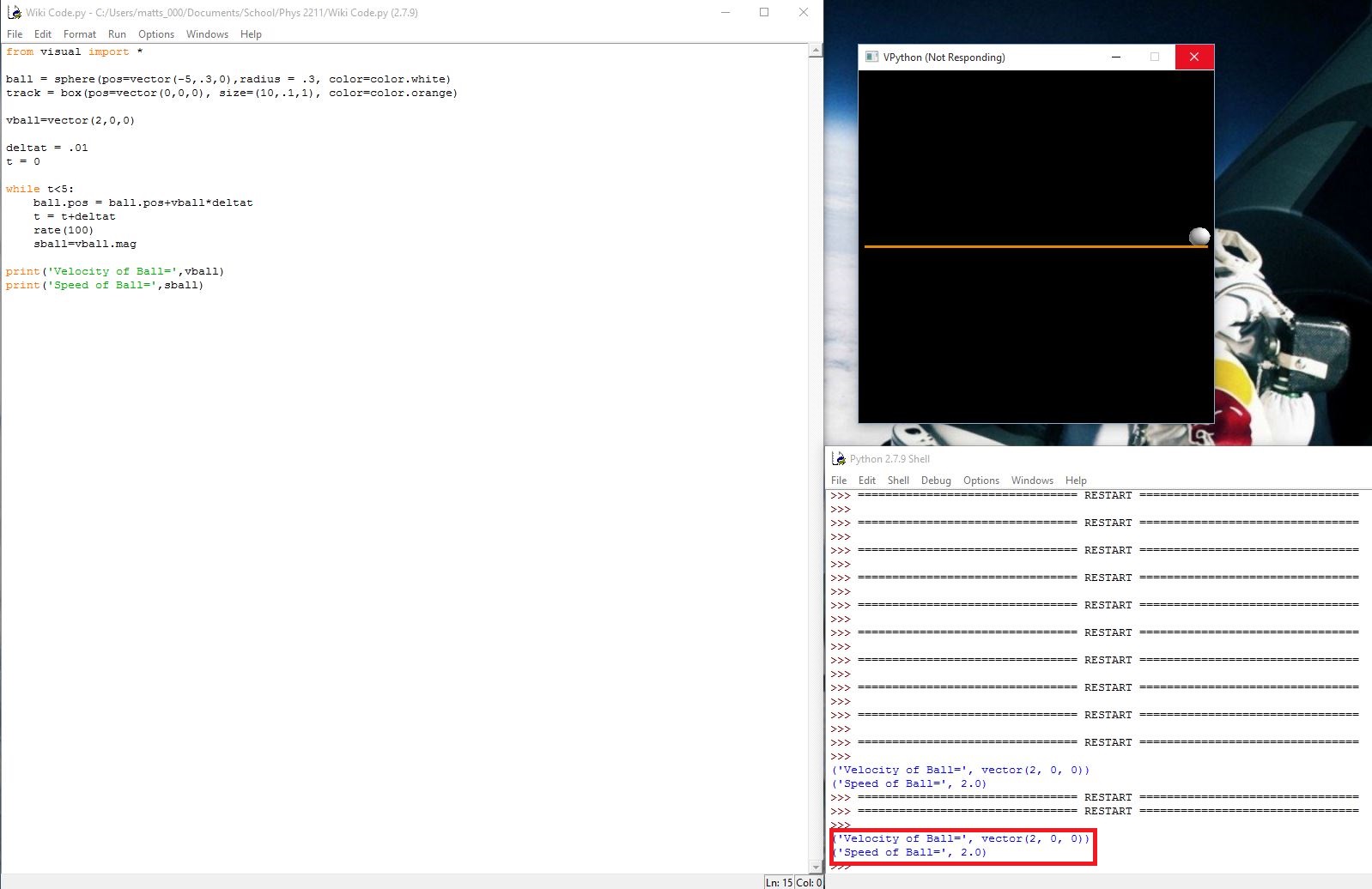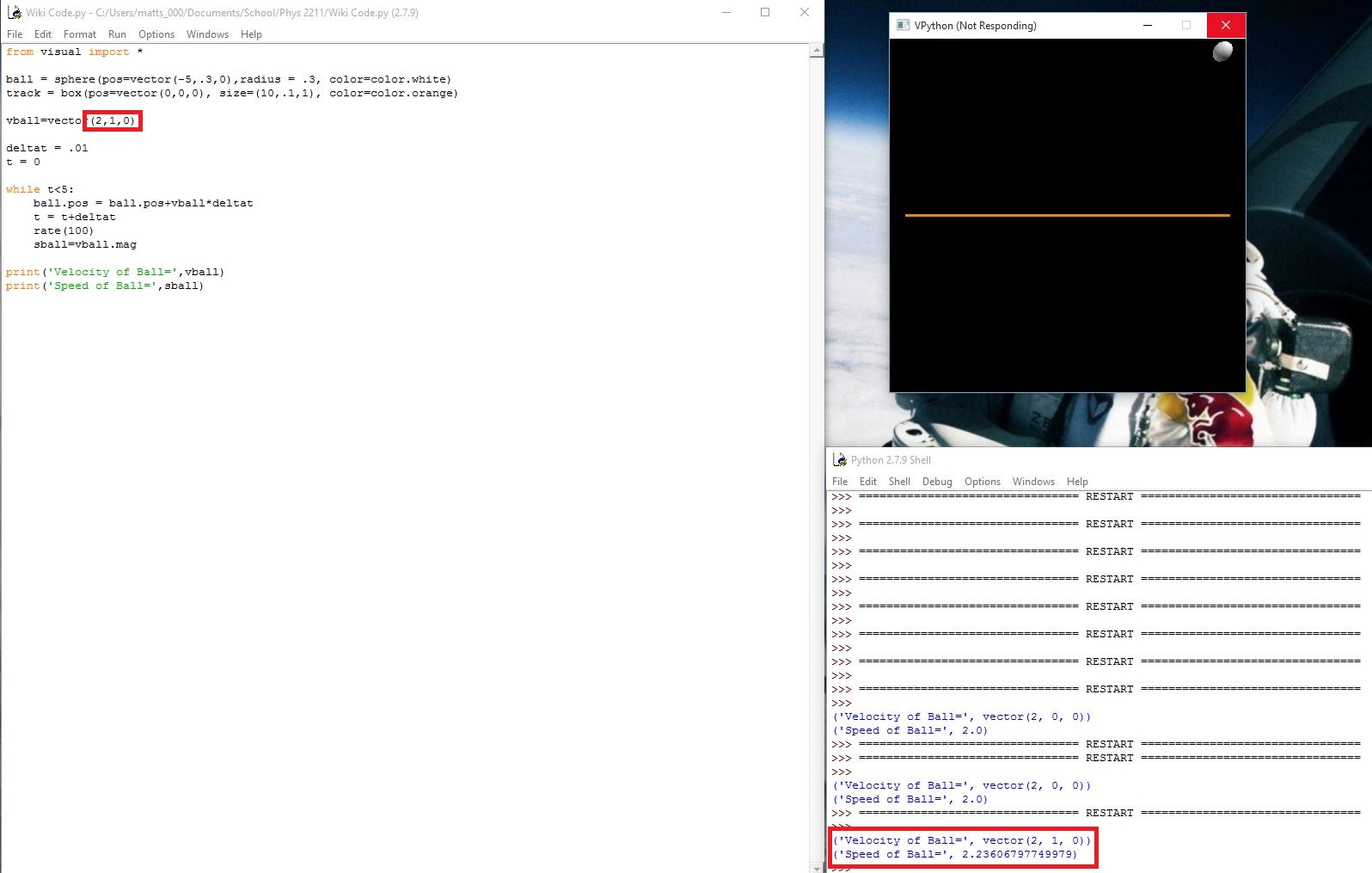Speed and Velocity
by Matt Schoonover
edited by Hyunsu Jo
Speed and Velocity
What is speed?
Speed is a single number which is a scalar quantity. It is the magnitude of velocity. In symbols, average speed could be expressed as,
[math]\displaystyle{ \boldsymbol{{Vavg}} = \frac{{d}}{{t}} }[/math], where [math]\displaystyle{ {\boldsymbol{Vavg}} }[/math] represents average speed, [math]\displaystyle{ {\boldsymbol{d}} }[/math] represents the distance an object moved, and [math]\displaystyle{ {\boldsymbol{t}} }[/math] represents the time elapsed. Average speed of a vector <x,y,z> could be found by the equation, Vavg = sqrt(x^2+y^2+z^2).
The equation could also be written as:
[math]\displaystyle{ {\boldsymbol{d}} }[/math] = [math]\displaystyle{ {{Vavg}} }[/math]*[math]\displaystyle{ {{t}} }[/math]
[math]\displaystyle{ \boldsymbol{{t}} = \frac{{d}}{{Vavg}} }[/math]
What is velocity?
Velocity is speed with direction. By knowing an object's speed(m/s) and direction of motion, we could find velocity. Average velocity could be expressed as, [math]\displaystyle{ \boldsymbol{\vec{v}} = \frac{\Delta\vec{r}}{\Delta{t}} }[/math], where Greek captial Delta, [math]\displaystyle{ {\Delta\boldsymbol{}} }[/math], represents a change in quantity. Because r is a representation of position vector, [math]\displaystyle{ {\Delta\boldsymbol{r}} }[/math] is in 3D <x,y,z> plane.
A Mathematical Model
Speed : [math]\displaystyle{ \boldsymbol{{Vavg}} = \frac{{d}}{{t}} }[/math]
Velocity: [math]\displaystyle{ \boldsymbol{\vec{v}} = \frac{\Delta\vec{r}}{\Delta{t}} }[/math]
A Computational Model
Difference between speed and velocity could be easily explained by the pictures of two computational models.
In the first computational model, the speed which is a scalar quantity(one dimension) is only in x-direction.

However, in the second computational model, the velocity is in both x and y direction which is in 3 Dimensional <x,y,z> plane which differentiates speed and velocity.
Simple Example
1) What is the average speed of a person who walked a distance of 15 meters in 3 seconds?
Answer: The average speed of a person is 5m/s. (b/c Average speed = d/t = 15/3 )
2) Find the velocity of a person running with the speed of 7m/s if the person's final displacement is <4,2,6>
Answer : The velocity of a person is 7m/s * <4,2,6> = <28,14,42>
Difficult Example
1) At time 0.3 seconds after the tennis ball has been hit by a tennis racket, the tennis ball is located at <4,7,3>m, relative to an origin of the tennis court. At time 0.6 seconds after the tennis ball got hit, it was located at <13, 10, 6>m.
What is the average velocity of the tennis ball?
Answer: <30,10,10>m/s (Explanation: <13,10,6>-<4,7,3>m/(0.6-0.3)s = <30,10,10>m/s)
What is the average speed of the tennis ball?
Answer:33.17m/s (Explanation: speed = sqrt(30^2+10^2+10^2) = 33.17m/s)
Connectedness
Both speed and velocity represents speed of an object. This is why speed and velocity are often interchangeably used in incorrect ways. Speed represents one dimensional speed of an object while velocity represents three dimensional speed of an object with directions of <x,y,z> plane.
See also
External links
References
Matter and Interactions, Modern Mechanics, 3rd Edition by Chabay and Sherwood.
Simple Examples
1. If a person walked a distance of 10 meters in 5 seconds, what is their average velocity?
Solution: Using the average velocity equation will tell you that the answer is 2 m/s.
2. If someone traveled with a velocity of 13 m/s for 3 minutes, how far would they have traveled?
Solution: First convert 3 minutes to seconds(180). Then use the velocity equation to solve for distance. You should get 2,340 m.
3. What is the unit vector for the velocity vector <3,4,0> m/s?
Solution: Use the speed equation to get that the speed is 5 and the unit vector equation to get a final answer of <3/5,4/5,0>
4. What is the velocity of an object if the unit vector is <3,2,1> and the speed is 5 m/s?
Solution: 5 m/s * <3,2,1> = <15,10,5> m/s
See also
- Kinds of Matter
- Detecting Interactions
- Fundamental Interactions
- System & Surroundings
- Newton's First Law of Motion
- Newton's Second Law of Motion
- Newton's Third Law of Motion
- Gravitational Force
- Terminal Velocity and Friction Due to Air
- Simple Harmonic Motion
- Electric Polarization
External links
- A physics resource written by experts for an expert audience Physics Portal
- A wiki book on modern physics Modern Physics Wiki
- The MIT open courseware for intro physics MITOCW Wiki
- An online concept map of intro physics HyperPhysics
- Interactive physics simulations PhET
- OpenStax algebra based intro physics textbook College Physics
- The Open Source Physics project is a collection of online physics resources OSP
- A resource guide compiled by the AAPT for educators ComPADRE
References
Matter and Interactions, Modern Mechanics, Volume One 4th Edition by Chabay and Sherwood.
